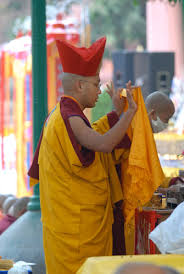法王新闻 | 2007年12月
『第25屆噶舉祈願』第七天报道
『25th Kagyu Monlam』The Seventh Day Report

地點:印度 菩提迦耶 金剛座 Mahabodhi Stupa, Bodhigaya, India
時間:2007年12月23日 23rd Dec., 2007
報導:噶舉祈願法會文宣組 Tashi Paljor
攝影:噶瑪善治 / 噶瑪諾布 / 生命電視台
布薩開示
Mahabodhi Temple: Procession of the Kangyur Just before dawn broke, Gyalwang Karmapa conferred the Sojong vows and gave a short teaching.
法王一早親臨會場,首先為與會大眾講授八關齋戒(大乘布薩)的整體利益和個別利益。這些利益又可分為時間上和地點上的利益。
根據經典,在五濁惡世,即使只持守大乘布薩戒中的一戒,功德利益也遠勝於供養成千上萬的佛。持守一次布薩的功德等如虛空,福樂之果綿綿不絕。
就地點而言,我們須要累積極大的福德才能前往現喜、極樂之類的淨土,但我們在這不淨世界受持大乘八關齋戒的功德,遠勝於在淨土修持布施等的功德。
持守八關齋戒的利益源於持戒的本質。持戒的本質使我們不受人、天、魔的侵害,得天人守護,令世間一切鬼神、天龍、邪魔等遠離。所以,持布薩等於守護自己。許多經典中都提到,布薩是守護自己最好的方法。
此外,持戒時,持戒者所作的一切善行,利益更大,善業更廣。若沒有持戒,外在善行及修誦就沒有絕對的利益。持戒時,持戒者的祈願容易成就。持戒也是成就人天的所依,能得天人善身果位。
在功德方面,八關齋戒是戒中最容易實行、最方便的。許多戒律,持守時須要保持專注,不能散亂,否則功德會減損。持守八關齋戒時,即使心有散亂,持戒者仍然能得到極大的功德利益。此外,八關齋戒的戒條較少,且時間較短(從受戒開始直到第二天日出), 易於持守。對初學者而言,這真是利大易行的方便法門。
布薩或八關齋戒共有八大戒條:不殺生、不偷盜、不淫、不妄語、不飲酒、不睡高廣大床、不非時食(過午不食)、不塗香及歌舞作樂。持守八戒的功德分別是:不殺生,得無病長壽;不偷盜,生生世世皆得福樂;不邪淫,來世莊嚴相好;不妄語,他人願聽從及敬重;不飲酒,令正知正念升起;不睡高廣大床,受他人敬重、頂禮,具身分地位;不非時食,來世飲食豐盛無匱;不塗香,來世身有香氣令人歡喜;不歌舞作樂使身心易於受攝,易得聞佛法。
雪域祖師勤守如此殊勝善法的德行,讓我們今天能聚集在聖地一起做大祈願,這真是稀有難得!領受布薩戒律時,我們應當思惟持戒的功德利益,歡喜地領受,然後歡喜地持守。
接著,法王親自傳授八關齋戒。
抬大藏經
The main event of the morning was the Procession of the Kangyur; all 108 volumes of the Sutra and Vinaya were carried by monks in procession around the outer and inner circuits of the Mahabodhi temple. The procession began from the bodhi tree at 7.30am. At its head came the incense-bearing, yellow-hatted chostenpas, the discipline masters, behind them a solitary monk blew a large white conch, which represents the sound of the Noble Dharma. After that came two monks blowing gyalings. Master Hai Tao, a Taiwanese lama, in the ochre robes of the Chinese Mahayana tradition, and the Venerable Hye Neung, Tibet House, Korea, in the long grey robes of a Korean monk, led the next section. They were followed by Mingyur Rinpoche, Gyaltsab Rinpoche, Jamgon Kongtrul Rinpoche and the Gyalwang Karmapa, in that order, wearing their red tsesha which signify high Rinpoches in the Kagyu tradition, and carrying posna (traditional Tibetan incense holders). They were followed by 104 gelongs and the 4 most senior gelongmas, each bearing a volume of the Kangyur, suspended between left shoulder and left palm. Slowly, gracefully, step-by-step, placing stockinged or bare feet mindfully on the stone pavement, the Sangha processed along the side of the Mahabodhi Stupa itself, up the steps and onto the outer circuit. There, thousands of people lined either side of the path, offering katags (Tibetan white ceremonial scarves), incense and flowers, particularly the long stemmed pink lotuses which can be bought from the urchins crowding round the entrance to the Mahabodhi site. In the background, from the area near the bodhi tree, came the sound of the chant master leading a slow chant of the refuge prayer in Sanskrit.
The morning sun shone down brightly on the processing monks and on the crowd, as the procession wound its way the complete length of the outer circuit before returning down the steps to the Mahabodhi temple itself and back to the bodhi tree.
The volumes of the Kangyur were then distributed to the different monasteries and sections of each volume, approximately ten pages, were allocated to individual monks, and the reading of the Kangyur began.
早上七點半,海濤法師、慧能法師、明就仁波切、嘉察仁波切、蔣貢仁波切及法王的引領之下,一百多位比丘及比丘尼抬著大藏經中全套甘珠爾繞塔,許多僧眾和在家眾手持蓮花和卡達夾道迎請。法王和所有的仁波切及藏傳僧眾,都穿著金黃色的法衣和法帽,大乘法師們也身穿三法衣,以示對法的敬重。四位比丘尼也在抬大藏經的行列之中。比丘尼的參與,在藏傳佛教是歷史性的大事,法王主持祈願法會之後,於2005年開始這項新傳統,可見法王對比丘尼傳統的尊重。繞塔之後,僧眾開始讀誦經文。
巡視寧瑪寺義診處及供餐
Gyalwang Karmapa visits the Nyingma Monastery: A fter the morning session at the Mahabodhi Temple, the Gyalwang Karmapa visited the Nyingma Monastery which is hosting getsuls and getsulmas (novice monks and nuns) for the midday meal. Gyalwang Karmapa watched as the monks and nuns formed orderly lines as they queued for their lunch. He inspected that day’s meal ¨C rice and lentils. He also visited the small clinic, offering Tibetan and allopathic medicine, and talked with the staff. The clinic is being run by Kagyu Monlam medical team: Dr Subatom from Nepal, and a Tibetan doctor Amchi Drubgyu Tendar from Rumtek, Sikkim.
第二座香結束之後,法王前往寧瑪寺,巡視西醫和藏醫合併的義診處,和主診的三位醫師會面,殷切詢問義診事宜。 接著,法王審查、品嘗此處供應的飲食。法會期間,參與法會的沙彌和沙彌尼及部分在家眾在此用餐,午餐的人數約在七千左右。法王的到來,讓在此用餐的僧俗大眾相當興奮,頂著大太陽,聚在廣場上,等待一賭法王風采的機會。法王在義診室陽台上觀察供餐的情況,並向大眾致意。
Gyalwang Karmapa eats lunch with the gelongs and gelongmas: During Kagyu Monlam the gelongs and gelongmas have been keeping the Sojong vows, so they do not eat after midday; lunch, their main meal, is served at Tergar Monastery. After the morning session at the Mahabodhi temple, buses transfer the nuns and monks to Tergar Monastery where they gather in the Main Hall, sit in long rows, and observe the new codes of conduct for sitting and eating. A team of Chinese Buddhist volunteers prepares cooks and serves the food each day as an offering and service to the sangha. Today Gyalwang Karmapa joined them for lunch: rice, vegetable tempura, mixed vegetables, French fries, paneer, yoghurt and fruit.
之後,法王回到德噶寺(聚藏寺),和參與祈願法會的比丘及比丘尼一起吃缽飯,同時表揚典座組及行堂組的義工。
不动佛超荐
Akshobhya Fire Puja: This was the conclusion of a week of the Akshobhya Ritual, a powerful purification practice, which Gyalwang Karmapa had been leading each afternoon at the Mahabodhi Temple.
The final ritual ¨C the fire puja ¨C was held in the main hall at Tergar Monastery shortly after 9.00pm, and did not end until 12.30am. Gyalwang Karmapa was Vajra Master. As part of the ritual, the names of the deceased, written on paper, were burnt in a ritual fire. Only a few lamas were allowed to participate in the ceremony, those who had completed the retreat and kept Sojong; other monks and the general public gathered outside and watched through the windows.
晚上八點過後,法王帶領八位戒律清淨閉關圓滿的喇嘛在聚藏寺大廳內,修持不動佛超薦法,超度亡者。超薦法會之前,八位喇嘛在法王的指導下進行二十一天的不動佛修法閉關。由於去年不動佛壇城尚未圓滿,去年登記的牌位在本次法會中才正式入火焚燒。法王親自一一宣疏唱名。法會長達三個半小時。
